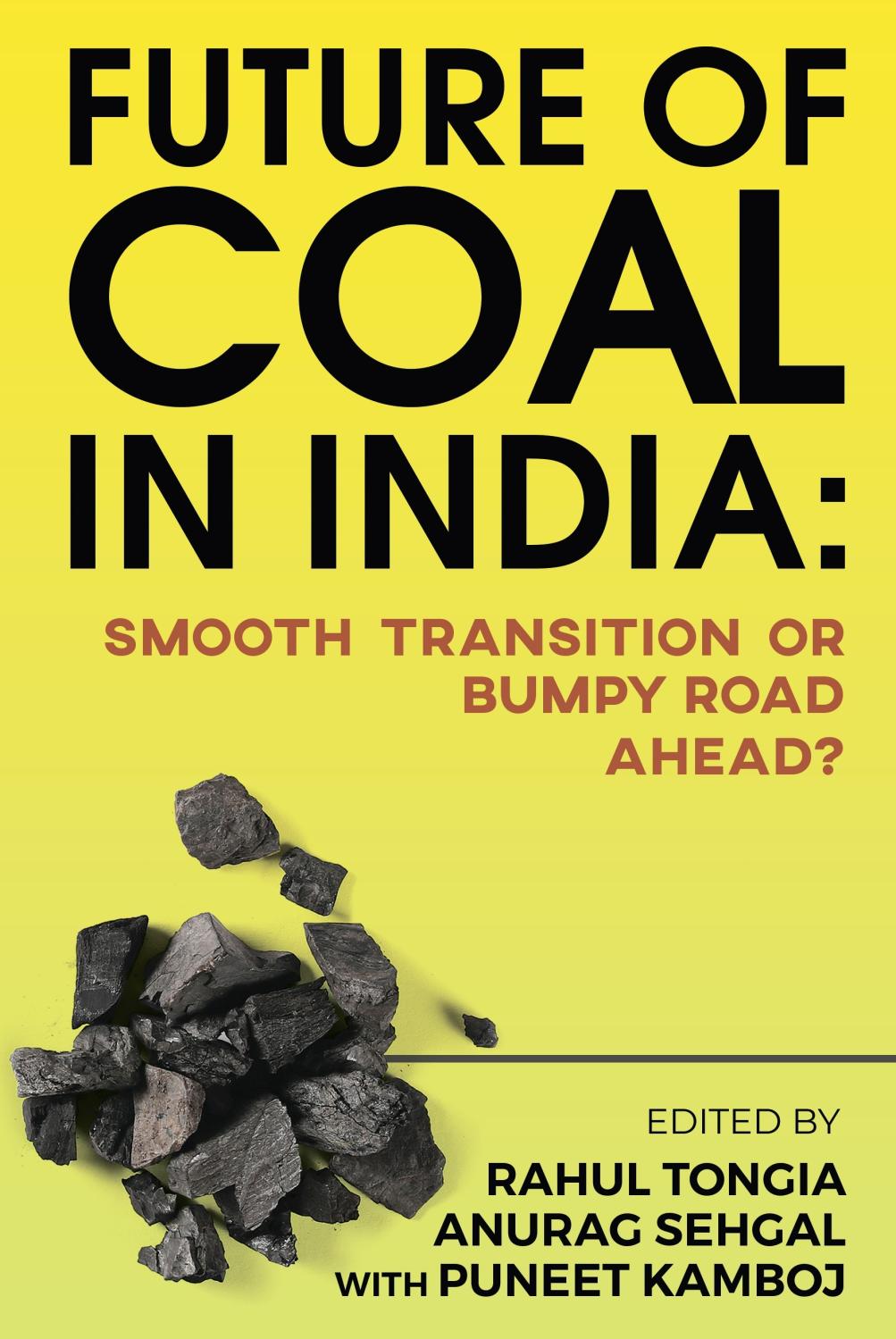Content from the Brookings Institution India Center is now archived. After seven years of an impactful partnership, as of September 11, 2020, Brookings India is now the Centre for Social and Economic Progress, an independent public policy institution based in India.
PRE-ORDER: COMING SOON
First published 2020 by Notion Press and Brookings India, ISBN: 978-1-64828-845-6, © 2020
Learn more about our upcoming book launch & panel discussion, on Monday, September 7 at 5:30PM IST »
No discussion of global climate change can ignore India, and no discussion of India’s energy future can ignore coal, which provides about half of India’s energy. Coal dominates because it is available domestically and cheap (especially without a carbon tax). If the global focus is on the energy transition, how does India ensure a just transition? Managing winners and losers will be the single largest challenge for India’s energy policy.
Across 18 chapters, drawing from leading experts in the field, we examine all aspects of coal’s future in India. We find no easy answers, but attempt to combine the big picture with details, bringing them together to offer a range of policy options. The Table of Contents shows the breadth of topics covered.
Coal is entrenched in a complex ecosystem. In some states, it’s amongst the largest contributors to state budgets. The Indian Railways, India’s largest civilian employer, is afloat because it overcharges coal to offset under-recovery from passengers. Coal India Limited, the public sector miner that produces 85% of domestic coal, is the world’s largest coal miner. But despite enormous reserves, India imports about a quarter of consumption.
On the flip side, coal faces inevitable pressure from renewable energy, which is the cheapest option for new builds. Local air pollution is a national crisis, with 7 of the world’s top 10 polluted cities in India. This places further pressure on coal-based power generation. However, there is significant coal-based power capacity already in place, some of which is underutilized, or even stranded.
Low per-capita energy consumption means India must still grow its energy supply. Before India can phase out coal, it must first achieve a plateau of coal. How this happens cost-effectively and with least resistance isn’t just a technical or economic question, it depends on the political economy of coal and its alternatives. Some stakeholders want to kill coal. A wiser option may be to first clean it up, instead of wishing it away. India has unprecedently ambitious renewable energy targets for 2030, calling for about a four times growth of today’s installed wind, solar, and hydro total electricity capacity. Even assuming India doesn’t start building any more coal power plants going forward, it still means that in 2030 about half of India’s electricity will come from coal.
Selected findings include:
- India actually uses a relatively modest amount of coal on a global scale, if we normalize per capita. Tons of coal is a slightly misleading metric since Indian coal is high-ash, which hurts local air pollution but also means a ton of US coal emits a third more CO2 than Indian coal.
- The present regulation of coal creates winners and losers by not just location but also by ownership (private versus public sector) and type of user (power plants versus other users). The locational aspect of coal is a key part of the puzzle. Coal is very cheap per ton at the mine, but has concentrated deposits in east/central India, which means increased environmental burden in those areas. In contrast, renewable energy is concentrated in South and West India, increasing the spread between states using clean energy and coal. This is also one reason the impact of the transition will hit the Indian Railways much sooner than Coal India Limited.
- While there are enormous negative externalities of coal, there are also substantial societal payouts from coal across the chain. At the mining level, the government enjoys dividend payments from Coal India Limited, and the railways, which dominates transportation of coal, receives an existential level of cross-subsidy from coal. We also cannot ignore the large revenues from taxes, royalties, and mining fees, which are amongst the highest in the world.
- While India imposes a Rs. 400/tonne (metric ton) cess upon coal, which even applies to imports, this is only about $5.5 per short ton of coal. If one were to convert this to an implicit carbon tax, it is only a little over $3/ton CO2. Imposing a high carbon tax will be difficult, especially given the implications on the price of electricity (the dominant use of coal).
- Going forward, India’s focus will be on the combination of a controlled transition, increasing domestic supply, growing renewable energy, and cleaning up coal emissions. These are each trillion rupee questions – how to achieve these in coordination instead of conflict remains the task at hand for policy-makers.
- If there were challenges before COVID-19, fiscal space and political will for systemic change become even more constrained in a post-COVID-19 world. While there is a clamour for a leapfrog or positive disruption towards sustainability in the “new normal,” there are also greater concerns over resiliency, local supply, and simply seeking cost-effective solutions. Either way, coal will remain part of the mix. How much is a question no one can accurately predict even ten years out, forget 20-30 years hence.
Reviews
“Coal has historically fuelled India’s rise, bringing energy to millions of households and generating useful economic activity. It continues to be the mainstay of India’s energy mix, even as concerns over climate change and air pollution have highlighted the need to pursue a more sustainable path forward. In this context, this book impressively flags the opportunities and challenges that the coal sector will face in the coming years. The breadth of issues is comprehensive and relevant to all those wishing to understand India’s mainstay source of energy.”
-Fatih Birol, Executive Director, International Energy Agency (IEA)
“Coal’s decades-long primacy is ending, because of declining costs of renewables, its own environmental impacts, and logistics constraints. This book brings out the systemic risks that the coal sector faces, as well as the restructuring opportunities over the next quarter of a century. You may or may not agree with all it says, but you will agree that all of it needs to be discussed today; this book is required reading for anyone who follows the Indian energy sector.”
-Ajay Mathur, Director-General, TERI, & Co-Chair, Energy Transitions Commission
Table of contents
Section I: Summary and Key Insights
1. ‘King Coal’ Isn’t Dead, but Future Indian Coal Won’t (And shouldn’t) Look like It Did in the Past
-Rahul Tongia
Section II: Coal Supply in India: From History to Future
2. India’s Coal Industry and CIL in Historical Perspective
-Rohit Chandra
S1. Global Coal: Production, Consumption, and Trade in the Era of Climate Change
-Peter Nicholls and Tarunika Vyas
3. Issues with Existing Coal Market in India: Monopolistic Structure and Implications of the Current Regime
-Partha S. Bhattacharyya
4. Existing and Emerging Challenges of Coal Production: Digging Deep into CIL and SCCL Operations
-Anurag Sehgal
5. Coal Pricing and Allocations in India
-Anurag Sehgal and Rahul Tongia
6. Policy Challenges for India’s Fledgling Coking Coal Sector
-Harsh Sachdev and Anurag Sehgal
7. Coal Mining Technology and Practices in India: Challenges and Prospects
-Raman Srikanth
8. Ease of Doing Business in Indian Coal Mining
-Dipesh Dipu
9. Future of Coal Supply in India: It’s not just about Coal India
-Rahul Tongia
Section III: Ecosystem of Coal: Supply Chain, Use and Demand
10. Bottom-up Scenarios of Coal Requirement by 2030
-Mohd. Sahil Ali
11. RE “versus” Coal: A False Framing when both will be Required
-Rahul Tongia
12. Power and Coal Sectors: A Dysfunctional Intertwining
-Daljit Singh
13. Coal Logistics and Supply Chain in India: The Premier Status of Railways and Coal
-Vivek Sahai and Puneet Kamboj
Section IV: Regulation and Societal links of Coal
14. The Social Contract from Coal to Renewables: Can the Win-Win also have Losers?
-Pallavi Roy
15. Environmental Impact of Coal
-Priyavrat Bhati
16. Pricing Carbon Externality: Context, Theory, Evidence and Lessons for India
-Mohd. Sahil Ali and Rahul Tongia
S2. Managing Corporate Climate Risk in a Fluctuating Policy Scenario
-Damandeep Singh, Gargi Sharma, and Divya Varma
17. Technology Solutions to Cleaner Coal and Power
-Anand B. Rao
Section V: Conclusion
18. Putting it all Together – The Path towards Cleaner and Viable Coal
-Rahul Tongia
Addendum
Coal after COVID-19
Authors
Edited by


